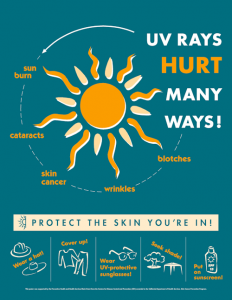
The U.S. Department of Health and Human Services has declared July UV Safety Month. The goal is to spread the word about how important it is to protect your skin from the harmful effects of the sun’s UV rays. So for this week's summer safely series, let's talk about how to stay safe in the sun.
UV radiation is the leading cause of skin cancer, which is the most common type of cancer in the U.S., but there are other complications from overexposure to the sun as well. These include eye problems (including cataracts and macular degeneration), a weakened immune system, skin texture changes, and premature aging (thick, wrinkled, and leathery skin).
- What are UV rays?
Ultraviolet radiation from sunlight reaches the earth's surface in the form of two types of UV rays. Long-wave UVA rays penetrate the skin's deepest layer, known as the dermis. They're also responsible for aging cells and causing wrinkles. Shortwave UVB rays can burn the superficial layers of skin. Both types damage skin cells and can lead to cancer.
- When is UV light strongest?
Damaging ultraviolet rays peak between the hours of 10 a.m. and 4 p.m. If you want to check their strength, observe your shadow. When rays are strongest, your shadow will appear shorter than you are. You can also get a local forecast by checking the UV index online.
- Who are most susceptible?
There are, unfortunately, certain types who are more prone to sunburns. Individuals, who are fair-skinned, have light colored hair (blond, red, or light brown), have freckles, and have light colored eyes (blue or green). In addition, some medications increase the skin’s sensitivity to UV rays and some lower or suppress the immune system, which makes your skin more susceptible to sunburns and other sun-induced ailments.
- How can you prevent UV damage?
- Go for the shade - Avoid or limit sun exposure during the hours where the sun’s UV rays are most intense—between 10 a.m. to 4 p.m.
- Wear protective clothing - Wearing long sleeve shirts and pants are ideal. Linens and thin cottons are probably the most comfortable fabrics during the warm summer months—as well as a broad-brimmed hat that shades the face, ears, and neck. Effective sunglasses should block glare and 99 to 100% of UV rays and have a wraparound shape to protect the eyes from all angles.
- Apply a broad-spectrum sunscreen - Many experts recommend making a daily habit of using creams, lotions, sprays and lip balms with a sun protection factor (SPF) of at least 30. Always select sunscreens with broad-spectrum protection, which shield against both UVA and UVB rays. And to ensure maximum effectiveness, buy new sunscreen products each year. Tip: Reapply sunscreen every two hours and after swimming and sweating, even if it’s labeled “water-resistant”.

Add new comment